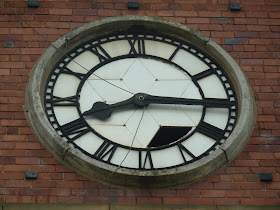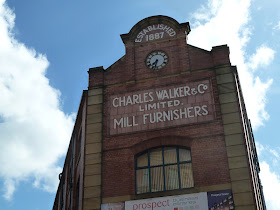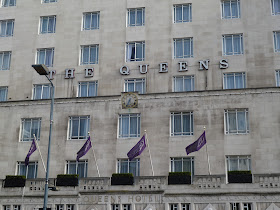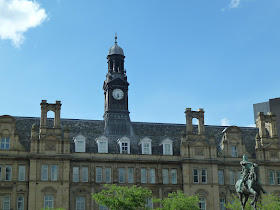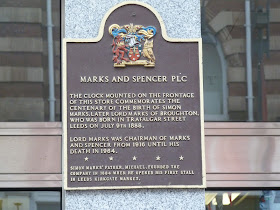This posting covers the area to the immediate south of Leeds city centre, and then jumps to Morley (which locals probably see as a separate town, but has too few clocks to have its own posting).
The south of the city is a mixture of industrial areas (thriving and derelict) and modern redevelopments. No prizes that it is the former that is the more interesting from a clock perspective (and many other perspectives too).
The first site visited is this industrial building on Hunslet Road that is currently being refurbished.
The clock face looks in pretty good condition......
..... although the hands on another face have seen better days. Lets hope that the clock is fully restored.
Just down the road is the very much still in use works of TF & JH Braime Ltd, with its Potts clock of 1915.
Rather more derelict are the premises of Knight and Illson Ltd on Water Lane. The clock itself has stopped, and the face has some damage.
Although in much better condition, Bridge End House has a stopped clock, which rather helpfully shows a different time on each of its faces.
Just round the corner is the Old Red Lion pub, with a rather non-descript clock set above a statue of a red lion (age not known).
Opposite are the old premises of Charles Walker & Co. Ltd, Mill Furnishers. I love these bold statements of ownership permanently set into the building which showed a great faith in the future and an investment in the building - not something you see very often with modern buildings. Shame that the clock is not working.
South now to Morley. For a relatively small settlement, the town hall is an impressive building with clock tower to match. The clock (another Potts) was installed in 1895, but was destroyed by fire in 1961. A new clock was installed, but the dials were repaired.
The only other clock I could find in Morley is on this derelict church. Despite being totally gutted, the dial and hands of the clock still remain.
A random look at public clocks in Britain, covering those on shops, public buildings, railway stations etc.
Sunday, 29 July 2012
Tuesday, 24 July 2012
Leeds (Part 3: City Centre - South)
To the southern part of the city centre:
The first stop is Holy Trinity church on Boar Lane. Originally built in 1722-27, the tower on which the clock sits is a later addition from 1839 after the original tower blew down.
The backdrop to the church is a construction site for another extension to Leeds renewed retail experience.
Not far from Holy Trinity is what was once the Griffin Hotel, its clock being a bit of a giveaway to its former identity. It is not readily apparent what the building now is - probably a mixture of uses. The clock is another product of Potts of Leeds from 1877.
Moving westwards along Boar Lane leads into Wellington Street. Here you can find the Queen's Hotel, built in 1937 by the LMS railway (the hotel fronts onto the railway station).
The clock is rather nice, but somewhat lost in the large facade.
Opposite the hotel is City Square, the location for the General Post Office building of 1896.
The statue is of the Black Prince, who has no connection whatsoever with Leeds, but was presented by the Mayor in 1899 as enshrining the chivalric ideal. Like that mayor's style!
Moving west on Wellington Street is the imaginatively named Wellington House. This is the home of Metro (or more properly the West Yorkshire Integrated Transport Authority), and also of this clock:
Further down Wellington Street is the much newer Regent House (indeed the name could be read as Recent House at first glance). It is always good to see new developments incorporating clocks, and this is a good example rather than the GRP tower add-ons that many new buildings go in for as an attempt to show tradition and cultural sensitivity. Okay, so I am not going to vouch for the authenticity of the materials used here, but full marks to this developer anyway.
Heading back to the city centre, it is time to pay a visit to the railway station. This is the 1938 concourse with its very simple but very striking clock. Elsewhere on the large station the only other timekeeping is of the electronic variety. Efficient for the passenger, but rather lacking in style or romanticism.
And behind the station is a multi-storey car park with this large clock. Not sure why it needs a clock, but hey why complain?
Right over now to the east of the city centre, and the Corn Exchange. This elliptical building was completed in 1862. The exterior merges into its surroundings, and has this fairly standard clock (you will be recognising the pattern of the dial face by now).
Inside is rather more grand, and the design makes most of the elliptical shape. The impressive clock is almost lost within the magnificent of the roof and general interior design.
On now to St Peters, the parish church, of 1844. Another church, another clock.
And finally, the Time Ball Building on Briggate. Originally two C17 houses, the facade was completely re-modelled and a time ball (falling at 1 pm) and this clock were added in 1910.
A second clock has this figure of Father Time, and the motto tempus fugit. However in this case there is not a lot of fugitting of the tempus going on as both clocks are stopped. In fact, I think that the real reason that this is called the Time Ball building is that the time it shows is a load of ....... ! But nice clocks though.
The first stop is Holy Trinity church on Boar Lane. Originally built in 1722-27, the tower on which the clock sits is a later addition from 1839 after the original tower blew down.
The backdrop to the church is a construction site for another extension to Leeds renewed retail experience.
Not far from Holy Trinity is what was once the Griffin Hotel, its clock being a bit of a giveaway to its former identity. It is not readily apparent what the building now is - probably a mixture of uses. The clock is another product of Potts of Leeds from 1877.
Moving westwards along Boar Lane leads into Wellington Street. Here you can find the Queen's Hotel, built in 1937 by the LMS railway (the hotel fronts onto the railway station).
The clock is rather nice, but somewhat lost in the large facade.
Opposite the hotel is City Square, the location for the General Post Office building of 1896.
The statue is of the Black Prince, who has no connection whatsoever with Leeds, but was presented by the Mayor in 1899 as enshrining the chivalric ideal. Like that mayor's style!
Moving west on Wellington Street is the imaginatively named Wellington House. This is the home of Metro (or more properly the West Yorkshire Integrated Transport Authority), and also of this clock:
Further down Wellington Street is the much newer Regent House (indeed the name could be read as Recent House at first glance). It is always good to see new developments incorporating clocks, and this is a good example rather than the GRP tower add-ons that many new buildings go in for as an attempt to show tradition and cultural sensitivity. Okay, so I am not going to vouch for the authenticity of the materials used here, but full marks to this developer anyway.
Heading back to the city centre, it is time to pay a visit to the railway station. This is the 1938 concourse with its very simple but very striking clock. Elsewhere on the large station the only other timekeeping is of the electronic variety. Efficient for the passenger, but rather lacking in style or romanticism.
And behind the station is a multi-storey car park with this large clock. Not sure why it needs a clock, but hey why complain?
Right over now to the east of the city centre, and the Corn Exchange. This elliptical building was completed in 1862. The exterior merges into its surroundings, and has this fairly standard clock (you will be recognising the pattern of the dial face by now).
Inside is rather more grand, and the design makes most of the elliptical shape. The impressive clock is almost lost within the magnificent of the roof and general interior design.
On now to St Peters, the parish church, of 1844. Another church, another clock.
And finally, the Time Ball Building on Briggate. Originally two C17 houses, the facade was completely re-modelled and a time ball (falling at 1 pm) and this clock were added in 1910.
A second clock has this figure of Father Time, and the motto tempus fugit. However in this case there is not a lot of fugitting of the tempus going on as both clocks are stopped. In fact, I think that the real reason that this is called the Time Ball building is that the time it shows is a load of ....... ! But nice clocks though.
Tuesday, 17 July 2012
Leeds (Part 2: City Centre - North)
The tour of the northern part of Leeds city centre starts with the Civic Hall in Millennium Square. The Civic Hall's architect was E Vincent Harris, and the building was opened in 1933. A key feature is the incorporation of two clocks on massive gilded frames. The picture below is of the west side clock, and shows the turtles around the dial.
This view of the other clock (on the east side of the building) shows how big the supporting bracket is, and shows a nice owl!
St George's church (opened 1838) is at the very west of the city centre, sandwiched between the inner ring road and Leeds General Infirmary.
The clock, installed by Dent in 1851, is in very good condition.
Staying with churches, St John's has a somewhat less cared for clock with most of the numerals severely worn away. St John the Evangelist, to give it its full name, was consecrated in 1634, and is Leeds' oldest surviving church.
Opposite the church on New Briggate is another of Leeds' shopping arcades, this time the Grand Arcade of 1897. At its eastern end (although up to 1938 located at the southern entrance on Harrison Street) is this animated clock by Potts of Leeds with medieval knights.
"Time and tide wait for no man", although in this case no man can wait for the time to change as the clock has stopped, despite its good external appearance. I do like the sun and moon figures on the hands.
And so to the Town Hall by Cuthbert Brodrick, built 1852-58, another part of Leeds' Victorian splendour (the building being opened by Queen Victoria herself on 7th September 1858).
The final clock in this part of the city centre is the more modern design to be found on the Leeds Building Society building (of 1930) a short distance along The Headrow from the Town Hall.
This view of the other clock (on the east side of the building) shows how big the supporting bracket is, and shows a nice owl!
St George's church (opened 1838) is at the very west of the city centre, sandwiched between the inner ring road and Leeds General Infirmary.
The clock, installed by Dent in 1851, is in very good condition.
Staying with churches, St John's has a somewhat less cared for clock with most of the numerals severely worn away. St John the Evangelist, to give it its full name, was consecrated in 1634, and is Leeds' oldest surviving church.
Opposite the church on New Briggate is another of Leeds' shopping arcades, this time the Grand Arcade of 1897. At its eastern end (although up to 1938 located at the southern entrance on Harrison Street) is this animated clock by Potts of Leeds with medieval knights.
"Time and tide wait for no man", although in this case no man can wait for the time to change as the clock has stopped, despite its good external appearance. I do like the sun and moon figures on the hands.
And so to the Town Hall by Cuthbert Brodrick, built 1852-58, another part of Leeds' Victorian splendour (the building being opened by Queen Victoria herself on 7th September 1858).
The clock is mounted in the tower which looms 69 metres above the city.
The final clock in this part of the city centre is the more modern design to be found on the Leeds Building Society building (of 1930) a short distance along The Headrow from the Town Hall.
Sunday, 8 July 2012
Leeds (Part 1: City Centre - Central)
The first of several postings on the clocks of Leeds, due to the sheer number of examples in the City. We start with the central part of the city centre. And what better way to start than with the fabulous shopping arcades and the magnificent clock in Thornton's Arcade.
The clock was installed when the arcade was built in 1877/78, and features characters from Sir Walter Scott's Ivanhoe. The figures are by John Wormald Appleyard, and the clock itself by William Potts & Sons of Leeds. Potts were a major clock manufacturer, and further details can be found in the excellent book "Potts of Leeds - Five Generations of Clockmakers" by Michael S. Potts published in 2006.
Nearby is the Queen's Arcade, this time with a clock signposting the arcade from the outside. Another Potts clock installed in 1890, this originally had a 5 feet diameter drum which was subsequently reduced in 1957 (and a Pattern 6 clockface if I'm not mistaken).
A few doors away on Briggate is the branch of Marks and Spencer. The plaque attached to the store explains the history behind the clock.
Also on the Briggate is another Potts clock, this time on what is now Harvey Nichols. Unfortunately it was running about three hours slow.
Still on Briggate is the branch of H Samuel. I assume their standard issue clock no longer works, and therefore the face has been covered up. I suppose it is better than leaving it to show to wrong time.
The nearby jewellers of Berry's on Albion Street and Owen and Robinson on Bond Street do somewhat better.
And I'm not sure if they are "making it special", but Beaverbrooks on Commercial Street at least have a fully functioning timepiece.
At the eastern side of the city centre is the bus station. Full marks to the security man who made sure that I did not take one step into the bus-only zone to get a better shot of the clock.
And finally back to the subject of Marks and Spencer, but this time to the clock in the Market Hall hat commemorates their original stall. (And full marks to the market for their colourful display for the Olympics).
Next stop will be the southern part of the city centre.
The clock was installed when the arcade was built in 1877/78, and features characters from Sir Walter Scott's Ivanhoe. The figures are by John Wormald Appleyard, and the clock itself by William Potts & Sons of Leeds. Potts were a major clock manufacturer, and further details can be found in the excellent book "Potts of Leeds - Five Generations of Clockmakers" by Michael S. Potts published in 2006.
Nearby is the Queen's Arcade, this time with a clock signposting the arcade from the outside. Another Potts clock installed in 1890, this originally had a 5 feet diameter drum which was subsequently reduced in 1957 (and a Pattern 6 clockface if I'm not mistaken).
A few doors away on Briggate is the branch of Marks and Spencer. The plaque attached to the store explains the history behind the clock.
Also on the Briggate is another Potts clock, this time on what is now Harvey Nichols. Unfortunately it was running about three hours slow.
Still on Briggate is the branch of H Samuel. I assume their standard issue clock no longer works, and therefore the face has been covered up. I suppose it is better than leaving it to show to wrong time.
The nearby jewellers of Berry's on Albion Street and Owen and Robinson on Bond Street do somewhat better.
And I'm not sure if they are "making it special", but Beaverbrooks on Commercial Street at least have a fully functioning timepiece.
At the eastern side of the city centre is the bus station. Full marks to the security man who made sure that I did not take one step into the bus-only zone to get a better shot of the clock.
And finally back to the subject of Marks and Spencer, but this time to the clock in the Market Hall hat commemorates their original stall. (And full marks to the market for their colourful display for the Olympics).
Next stop will be the southern part of the city centre.






